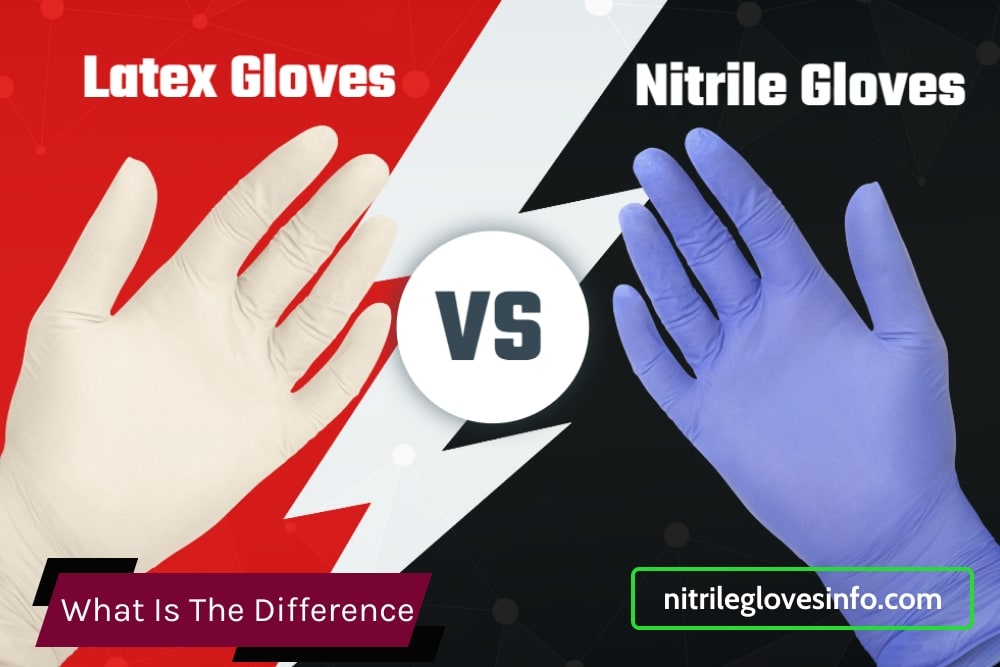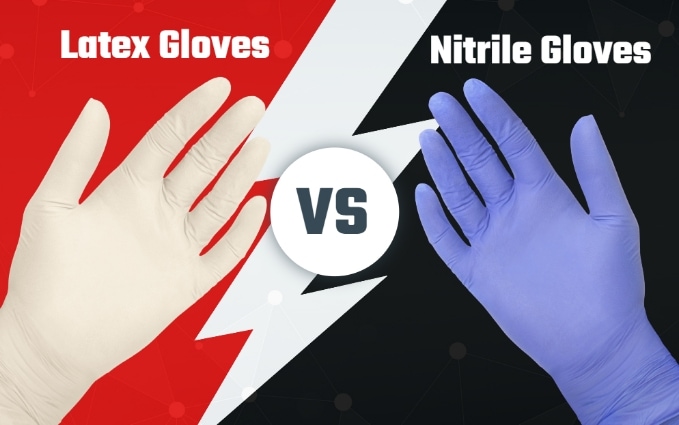
There are many different types of gloves, and one of the most commonly confused ones is latex and nitrile. Although these gloves share a lot of similarities, and be a great alternative but there are some key differences that you should know about if you want to get the best quality pair.
Table of Contents
- What is disposable glove?
- What is powder-free and powdered gloves.
- What are nitrile gloves?
- What are latex gloves?
- What is the Difference Between Disposable Latex and Nitrile Gloves?
- Safe Guard Latex Gloves
- What are the advantages of using latex gloves?
- Latex is more flexible and softer than nitrile.
- Latex is more puncture resistant than nitrile.
- Latex has high dexterity and will fit more comfortably.
- Latex is cheaper than nitrile gloves.
- Latex glove has high degree of touch sensitivity
- Latex is more elastic than nitrile and can stretch a lot without tearing.
- What are the disadvantages of using latex gloves?
- Latex is a skin irritant and can cause allergic reactions in some people.
- Latex has a shorter lifespan, which makes it difficult to maintain.
- Latex is less durable than nitrile.
- Latex is less strong than nitrile rubber.
- Latex is less chemical resistant than nitrile.
- The protein in the latex can cause allergic reaction.
- MedPride Powder-Free Nitrile Exam Gloves
- What are the advantages of using nitrile gloves?
- Nitrile is more resistant to puncture than latex.
- Nitrile is stronger and sturdier than latex.
- Nitrile is more hygienic than latex
- Nitrile is more resistant to chemicals than latex.
- Nitrile gloves are also very inexpensive and can be purchased in bulk.
- Nitrile gloves will not cause allergic reactions like latex gloves do.
- Nitrile gloves are use in various industries
- What are the disadvantages of using nitrile gloves?
- Nitrile gloves are less flexible
- Nitrile will not deteriorate as quickly
- What are the common allergic reactions to latex gloves?
- Questions and Answer of Nitrile Gloves
- Which type of glove is best for the type of work that you do?
- Why do gloves need to be replaced?
- Which are better for heavy duty work or oily jobs?
- Which type of glove is best for medical facilities?
- Which type of glove is best for women who have sensitive skin or allergies?
- Which type of glove is best for those who have a latex allergy?
- Which type of glove is best for retaining touch?
- Do latex or nitrile gloves hold up better when punctured or torn?
- Why aren’t there nitrile condoms?
- Can you reuse nitrile gloves?
- What is the difference between nitrile and vinyl gloves?
Nitrile gloves are commonly used in healthcare and other industries as barrier protection, but they can also be found at many different stores. Nitrile is a synthetic material that comes from petroleum, while latex gloves come from the sap of rubber trees. They both work to keep you safe when handling potentially harmful materials, but there are some important differences.
This blog will go over the differences between these two types of gloves, and explain which gloves are best for your needs.
What is disposable glove?
Disposable rubber gloves are personal protective equipment for infection control. There are many type of disposable gloves which are made from different materials such as latex, nitrile, vinyl, PVC, PPE etc. The basic purpose of disposable gloves is protecting bodily fluids, but sometimes they also get in the way so you have to throw them away after a while instead of using them for your protection at all times
Disposable means that they are not reusable. There is no reason to wear these gloves again after the first time you used them. They are great for many jobs such as working in a factory, kitchen, cleaning or laboratory. This disposable gloves can prevent contamination because they are not reused.
People confuse among latex gloves, nitrile gloves and vinyl gloves. They are different in terms of glove material, quality and price. Disposable gloves are disposable because they will wear out or get torn when you use them to do some work like opening the can or taking out the trash.

What is powder-free and powdered gloves.
Both nitrile gloves and latex gloves can be powdered and powder-free. For powdered gloves, when you take a closer look, it is easy to see how little powder there really is in your glove. Powder is made by adding talc or cornstarch. Powder-free means that there is no talc, cornstarch or other materials added to the gloves.
The benefits of powder are that it reduces friction between the gloves and your skin. It also makes them feel lighter on your hands. Powder-free gloves are usually more expensive than powdered ones, but they provide a better grip and offer more comfort to you during work. However, powder may cause skin allergies. So., powder-free gloves are made from materials that do not cause any allergic reactions. The powder-free gloves are the best because they don’t have any powder in them.
What are nitrile gloves?
Nitrile gloves are made by butadiene, while latex gloves are made by natural latex rubber. Butadiene is a synthetic material, which is considered to be less expensive than natural rubber. The synthetic material butadiene is considered to be the cheaper alternative of natural rubber. This material is used to make nitrile gloves.
Nitrile is an organic compound that can be made into different types of products, such as electrical insulators or artificial rubber. It is commonly found in personal care products, pharmaceuticals and more.
What are latex gloves?
Latex is a natural product that comes from the sap of rubber trees. It can be found in various different forms, such as rubber cement or even gloves used by surgeons during surgeries. Latex is also used in medical products, such as syringes and catheters.
latex gloves were recommended in the 1980s and 1990s to protect healthcare workers from bloodborne pathogens like HIV (or covid-19), but they are now causing allergic reactions.
What is the Difference Between Disposable Latex and Nitrile Gloves?
Do you know the difference between nitrile and latex gloves? Well, there are some major differences between these two types of gloves. If you need to learn more about the features of nitrile and latex gloves, then read on to find out more about them.
There are many differences between latex and nitrile gloves, but the most important ones are that they both protect your hands from potentially harmful substances. Nitrile is a synthetic material, while latex comes from natural rubber trees.

Materials :
Latex and nitrile gloves are the most commonly used types of gloves. Latex is a natural product and is derived from rubber trees. It is also known as natural rubber or rubber tree rubber. Nitrile is a synthetic material that has been used in gloves since the 1950s. Both latex and nitrile are suitable for most jobs, but they have their own advantages and disadvantages.
Environment :
The difference between latex and nitrile gloves is that the former is a natural material, while the latter is synthetic. In general, nitrile gloves are preferred for industrial purposes as they are less expensive and more comfortable to wear.
Nitrile gloves can be used in harsh environments like chemical plants and oil refineries. Nitrile gloves can also be used in meat processing plants and meat packing plants. On the other hand, latex gloves can be used in all kinds of food processing plants.
Chemical resistance :
Nitrile is very resistant to chemicals and oil, whereas latex is less resistant to chemicals and oil. Nitrile gloves are suitable for jobs that require hands to be exposed to chemicals and oil.
Thickness :

Different thickness provide different strengths. Nitrile gloves is more resistant than latex gloves in terms of thickness. Latex has a lower resistance, but it is more comfortable on the skin .
Wear resistance :
Nitrile gloves are the type of gloves that are most used in hospitals. Nitrile gloves are manufactured from a synthetic rubber called nitrile, which is more flexible than latex. Nitrile is also resistant to oil, grease, solvents and alcohol. The skin of nitrile gloves is smooth and does not cause irritation when touched. Nitrile gloves are better suited for people with sensitive skin.
Odor control :
Latex gloves are not resistant to odor. When exposed to oil, the latex absorbs the odors. Nitrile gloves are more suitable for jobs that require hand exposure to chemicals and oil.
Wash resistance :
Latex gloves are not resistant to washing. Latex rubber will absorb water and become softer, causing the glove to tear. Nitrile is more resistant than latex in terms of wash resistance because it does not absorb water or oils during hand exposure.
Flexibility :
Latex is more flexible than nitrile. Nitrile gloves are generally preferred for jobs that require hands to be exposed to chemicals and oil. Latex can also cause irritation in sensitive skin, whereas nitrile gloves are smooth and do not cause irritation when touched.
Durability :
Latex is more durable than nitrile. Latex can be used in extreme temperatures, whereas nitrile gloves are not resistant to extreme temperature. Latex is also less prone to tearing compared with nitrile.
Strength :
Latex is more resistant to puncture than nitrile. Latex can be torn by hard objects such as glass, whereas nitrile will not tear even when exposed to sharp objects.
Puncture Resistance:
Latex is more resistant to puncture than nitrile. Latex can be torn by hard objects such as glass, whereas nitrile will not tear even when exposed to sharp objects.
Softness :
Latex is more flexible than nitrile. It is soft and smooth and can cause irritation when touched. Nitrile is more rigid and will cause irritation if the glove touches sensitive skin.
Stickiness :
Latex is more sticky than nitrile. Latex will stick to skin when worn, whereas nitrile gloves are smooth and do not cause irritation when touched.
Allergies :
Latex gloves are more likely to cause allergic reactions than nitrile. Latex is not as hygienic as nitrile because it can harbor bacteria and may contain allergenic substances.
latex-free:
Nitrile gloves are latex-free . Latex gloves may contain protein, which is a common allergen. Latex gloves are more likely to cause allergic reactions than nitrile gloves because they can harbor bacteria and may contain allergenic substances.
SafeGuard are made with a powder-free design that helps keep hands clean and free of lint.
What are the advantages of using latex gloves?
People usually think that nitrile gloves are better than latex gloves. However, the advantages of using latex gloves over nitrile gloves should be looked at differently. The main advantages of using latex gloves are as:
Latex is more flexible and softer than nitrile.
Latex is more flexible and softer than nitrile because it is more elastic and less rigid. Nitrile gloves are stiffer than latex gloves. Latex gloves will stretch to fit the shape of your hand, whereas nitrile will not stretch at all because it is a gas-tight material that does not change shape. Latex gloves are better for delicate work like handling food, applying makeup, and writing.
Latex is more puncture resistant than nitrile.
Nitrile will tear easily and expose the wearer to potential dangers such as glass shards, sharp objects, or abrasive surfaces that can cut into the skin
Latex has high dexterity and will fit more comfortably.
The main advantage of using latex gloves is that they are very easy to clean and maintain. Latex gloves are also known for their high dexterity and will fit more comfortably. Latex gloves are usually used in industries like food processing, medical, agriculture, pharmaceuticals, cosmetics, printing and publishing etc.
Latex is cheaper than nitrile gloves.
Latex gloves are more affordable than nitrile gloves. Nitrile gloves are very expensive because they are made of synthetic rubber. Latex gloves are manufactured from natural rubber which is much cheaper than nitrile.
Latex glove has high degree of touch sensitivity
Latex gloves are considered to be the best choice for handling sensitive or hazardous items. Latex gloves are made of natural rubber latex, which is also known as natural rubber. Latex gloves are extremely soft and pliable.

Latex is more elastic than nitrile and can stretch a lot without tearing.
Latex is more elastic than nitrile and can stretch a lot without tearing. Latex gloves are more durable than nitrile gloves. Latex gloves are also cheaper than nitrile gloves. Latex gloves are available in different colors and designs, whereas nitrile gloves are available only in black color.
What are the disadvantages of using latex gloves?
Latex gloves are a great way to protect yourself and other people from disease-causing bacteria. However, they also pose a risk of allergic reactions and even deadly reactions. Here’s everything you need to know about the benefits and disadvantages of using latex gloves.
Latex is a skin irritant and can cause allergic reactions in some people.
Latex gloves are considered to be one of the safest materials used in healthcare, however, they are also one of the most expensive. Latex gloves are used for tasks that are considered to be high risk, such as operating on people or giving injections. The most common symptoms of latex allergy include skin rashes, itching, hives, asthma attacks and difficulty breathing.
Latex has a shorter lifespan, which makes it difficult to maintain.
Latex gloves are used to protect the hands from the harmful effects of chemicals, dust and other allergens. Latex is a natural material which helps in keeping your hands clean and hygienic. However, it has a shorter lifespan, which makes it difficult to maintain. Latex gloves should be replaced every six months.
Latex is less durable than nitrile.
Latex gloves are less durable than nitrile gloves. Latex gloves are less effective in protecting against disease transmission. Latex gloves are more expensive than nitrile gloves.
Latex is less strong than nitrile rubber.
Latex gloves are less strong than nitrile gloves. Latex is more porous than nitrile, which makes it more likely to break down when it comes in contact with certain chemicals, oils, or liquids. Latex can also lose its flexibility over time, which makes it less effective for some tasks. Nitrile gloves are also more durable and can be washed with water without losing their shape or elasticity.
Latex is less chemical resistant than nitrile.
Latex gloves are less chemical resistant than nitrile gloves. Latex gloves are very fragile and tear easily. Nitrile gloves are more durable and can resist more chemicals. Latex gloves are suitable for light-duty use only.
The protein in the latex can cause allergic reaction.
Latex gloves are known to be the most durable gloves available in the market. However, they are not 100% safe. In fact, there are many people who have developed allergic reactions to latex gloves.
Comfortable fit with textured fingertips for excellent tactile sensitivity.
What are the advantages of using nitrile gloves?
Nitrile gloves are known to be the best disposable gloves for all your work needs in general public. They are highly recommended because of their safety and high durability.
Like latex, nitrile rubber has a low level of allergenicity and is more puncture resistant than other types of gloves. Some disposable gloves can be reused because they have been properly cleaned and disinfected. Other disposable gloves cannot be re-used as standard practice with the CDC recommendations that involve cleaning them with soap or another germicidal agent before using them again to prevent the spread of infection.
The following section talks about the various advantages of using nitrile gloves.
Nitrile is more resistant to puncture than latex.
Nitrile gloves are more resistant to puncture than latex. Nitrile gloves are not only more resistant to puncture, but they also provide similar dexterity and feel in comparison to latex.
Nitrile is stronger and sturdier than latex.
Nitrile gloves are stronger and sturdier than latex. They are also more effective at protecting your hands from chemicals, as well as providing a better grip on slippery materials. They also offer better protection against skin irritation and infection.
Nitrile is more hygienic than latex
It cannot harbor bacteria and can be used for longer periods of time without causing irritation or discomfort. Nitrile gloves are more hygienic than latex gloves. They are less likely to trap bacteria, and they don’t give off the stench that latex gloves do.

Nitrile is more resistant to chemicals than latex.
Nitrile gloves are more resistant to corrosive chemicals than latex. Latex gloves have limited protection. Nitrile gloves are less likely to be damaged by acids, alkalis, and oil. Nitrile gloves also absorb less sweat and oils than latex.
Nitrile gloves are used for handling and handling of hazardous substances. There are various health risks associated with nitrile gloves, but they are used to handle and handle hazardous substances. The use of nitrile gloves has been made compulsory by the government for handling hazardous substances. Nitrile gloves are also used for food preparation and handling of perishable foods.
Nitrile gloves are also very inexpensive and can be purchased in bulk.
Nitrile gloves are easy to use and can be purchased in bulk. You can get cheap nitrile gloves here! These gloves are also available in different sizes and shapes. Nitrile gloves can be used in many types of industries.
Nitrile gloves will not cause allergic reactions like latex gloves do.
Nitrile gloves are made from synthetic rubber, which is also used in making some other rubber products. Nitrile gloves are not made from natural rubber latex, which is known to cause allergic reactions.
Nitrile gloves are use in various industries
Nitrile gloves are considered to be the most common type of glove. They are used in industries like, food and beverage, health care, pharmaceuticals, and home care.
What are the disadvantages of using nitrile gloves?
Nitrile gloves are a popular choice for those who want to be as clean as possible. Nitrile gloves protect the wearer from dirt, grease, and germs and help prevent transmission of infections like herpes and influenza. But there is a small cons as follows:
Nitrile gloves are less flexible
Nitrile gloves are less flexible than latex gloves. Nitrile gloves are more rigid and stiff, which means they are less flexible. This makes it difficult to get a good grip on things.
Nitrile will not deteriorate as quickly
Nitrile gloves are more durable than latex gloves, which means they will not deteriorate as quickly.
Nitrile gloves may contain traces of chemicals like dioxins and pesticides that can be harmful to the environment.

What are the common allergic reactions to latex gloves?
When working with latex gloves, some people may experience allergic reactions. The most common type of allergic reaction is an itchy rash on the skin. Other reactions can include redness and swelling in the eyes, nose, throat, or tongue. Allergic reactions are more likely to occur if the wearer has skin sensitivities or allergies to latex.
Questions and Answer of Nitrile Gloves
Which type of glove is best for the type of work that you do?
There are many different types of gloves that can be used for a variety of different jobs. Before choosing the type of glove that is best for you, think about what kind of work you do and which part of your body will get exposed to the chemicals in the environment. It may be more comfortable to wear a glove that has a good fit and is flexible.
Why do gloves need to be replaced?
Gloves should be changed as soon as they become damaged or worn out. This will ensure that you are able to protect your hands from chemicals in the environment and prevent infection .
Which are better for heavy duty work or oily jobs?
Nitrile gloves are better for heavy duty work or oily jobs. They are more durable and provide a better grip.
Which type of glove is best for medical facilities?
Nitrile gloves are best for medical facilities. They have been approved by the FDA (in united states) and have a longer shelf life than latex gloves. Nitrile gloves can be used as medical applications.
Which type of glove is best for women who have sensitive skin or allergies?
Nitrile gloves are best for women who have sensitive skin or allergies. They are more comfortable and provide a better grip.
Which type of glove is best for those who have a latex allergy?
Nitrile gloves are best for those who have a latex allergy. Nitrile does not contain protein , which is the ingredient that causes latex allergies.
Which type of glove is best for retaining touch?
Nitrile gloves are best for retaining touch. They provide a better grip and offer more protection than other types of gloves.
Which type of glove is best for jobs that require dexterity?
Latex gloves are best for jobs that require dexterity because they provide a better grip and flexibility.
Do latex or nitrile gloves hold up better when punctured or torn?
It is not that easy to distinguish between the two. Nitrile gloves are more flexible than latex gloves, so it is more likely for nitrile gloves to tear. However, both types of gloves offer the same level of protection against infections and diseases which makes them equally good.
Why aren’t there nitrile condoms?
Nitrile is not that good in wet conditions because it’s not as strong and flexible as the others are normally used in wet situations. Moreover, Natural rubber has a lot more flexibility than nitrile rubber does. It is softer and can stretch further before breaking or tearing up.
Can you reuse nitrile gloves?
Many experts, particularly doctors, say that nitrile gloves should not be reused. The reason they’re bad for you is because they’re porous and don’t maintain their protective qualities when they get wet. If you do use them again, however, experts say that the chances of contaminating your work area with harmful bacteria are slim.
What is the difference between nitrile and vinyl gloves?
See here!


